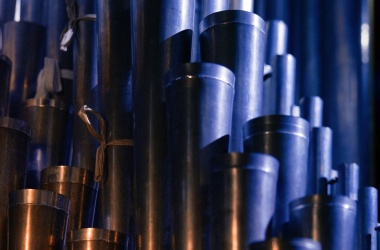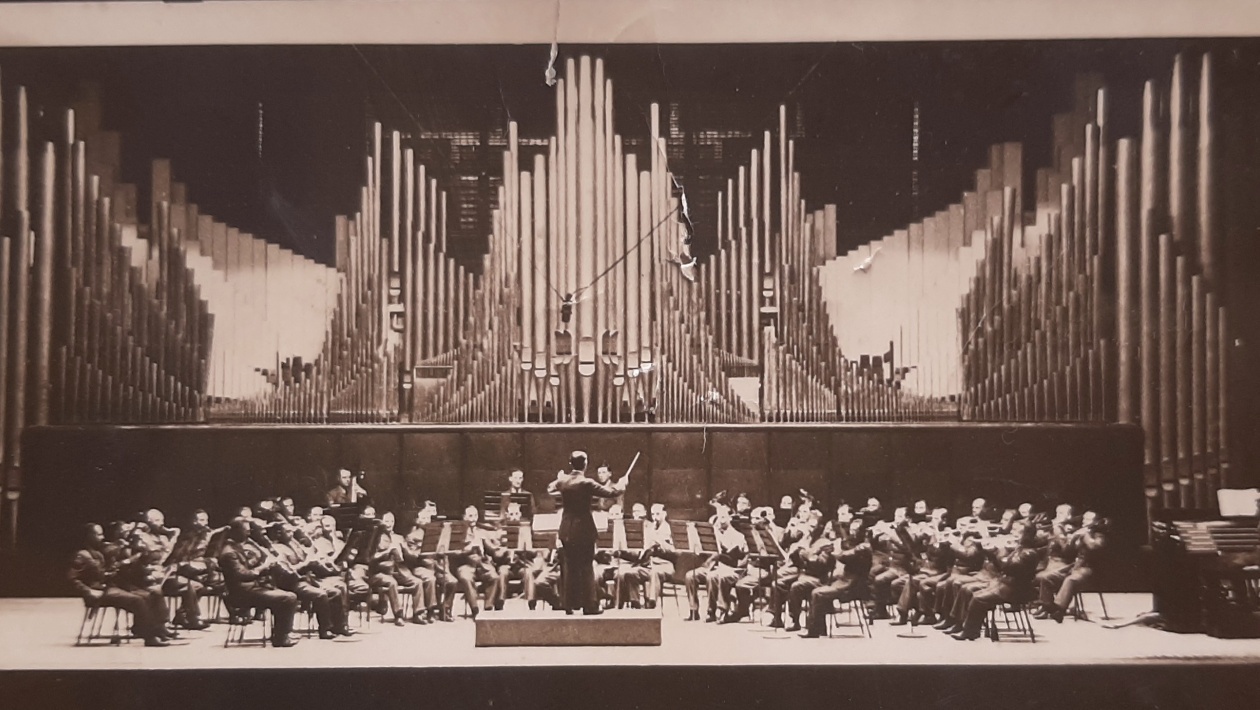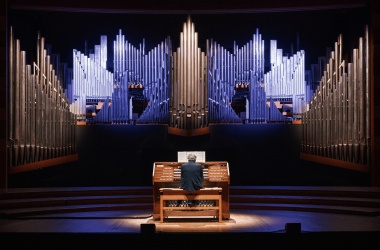
DEMOLITION OF THE PALAIS DU TROCADÉRO AND CONSTRUCTION OF THE PALAIS DE CHAILLOT
To make way for the World’s Fair in 1937, known as the “International exhibition of arts and techniques in modern life” [Exposition internationale des arts et techniques dans la vie moderne], the plan was to demolish the Palais du Trocadéro and replace it with a new palace, the Palais de Chaillot. However, a shortage of funds and the fall of Édouard Daladier’s government in February 1934 prompted Auguste and Gustave Perret to abandon their initial plan to demolish the entire Palais du Trocadéro and instead recuperate as much as they could of the old palace. In the end, only the festival hall [Salle des fêtes] was destroyed, to open up the view. The winning plan was drawn up by Léon Azéma, Louis-Hippolyte Boileau and Jacques Carlu. The festival hall was assigned to the brothers Jean and Édouard Niermans.
The new complex was therefore an Art Deco refurbishment of the old Neo-Byzantine palace. The festival hall was now at below-ground level, underneath the new esplanade, and its capacity had been more than halved.
The Théâtre national populaire (TNP) was transferred to the Palais de Chaillot, as was the organ, which had amply demonstrated its qualities in the previous venue. The building retained its role as a political symbol, as can be seen in the ideology-laden decors and especially the quotation by the poet Paul Valéry inscribed on its pediment: “Every man creates, without knowing it / Just as he breathes / But the artist feels himself creating / His act engages his whole being / His beloved pains fortify him.” In 1939, the facade was decked with flags to mark the 150th anniversary of the Revolution. On 24 and 25 of July 1945, the state funeral service for Paul Valéry was held at the Palais de Chaillot. The armistice altered the course of the building’s destiny: in 1945, the TNP initiative was brought to an end and its place taken by the United Nations departments. On 19 December 1948, the building witnessed the adoption of the Universal Declaration of Human Rights. Ten years later, the tenth anniversary of the founding of the State of Israel was celebrated there.
In 1951, Jean Vilar was appointed director of the newly-revived Théâtre national populaire, which, after a year divided between Suresnes and the Théâtre des Champs-Élysées, took up permanent residence at Chaillot in 1952.
REINSTALLATION OF THE ORGAN
Because the organ concerts had been a great success in the Trocadéro, the State decided to rebuild the organ in the new building. Marcel Dupré was tasked with supervising the organ’s dismantling in 1935, which was undertaken by Debierre’s successor, Gloton. The pipes were stored in crates in a school in Rue de Verneuil, in the 7th arrondissement. It remained to decide who would rebuild the organ, and how. A committee was set up for the purpose, formed of five Parisian organists representing a variety of currents, namely: Charles Tournemire (Sainte-Clotilde), Ludovic Panel (Sacré-Cœur), Joseph Bonnet (Saint-Eustache), Marcel Dupré (Saint-Sulpice) and Édouard Mignan (Madeleine).
The meticulous set of specifications drawn up recommended adapting the organ to the new requirements of the contemporary repertoire. This meant:
– Electrify the traction;
– Build a mobile console;
– Extend the manuals to 61 notes and the pedal keyboard to 32 notes;
– Scrupulously respect the old piping;
– Transform the Romantic organ into a neo-Classical organ by adding new stops, including mutations and mixtures;
– Keep the original windchests and add ancillary windchests for the added pipes (top pipes, new stops);
– Add a combination pedal;
– Add a crescendo pedal in addition to the two existing expression pedals;
– Reduce the number of pressures to one per division, making a total of five different pressures;
– Build a Montre 32’ (metal Principal) using the non-speaking, purely decorative pipes of the Trocadéro organ (the chanoines) and adding the three missing low pipes (C, C# and D);
– Swell and Choir bearing the 73-note windchests (low or high octave couplings).
On 8 May 1936, the contract was awarded to Victor Gonzalez, who was competing against Roethinger (Strasbourg) in the final round. His son Fernand (who was to die tragically at the age of 36 during an air battle in June 1940) designed the facade, an impressive blaze of pipes with no case, set around the central turret formed by the new Montre 32’ stop. The stops which are not enclosed are positioned on the façade, which fans out majestically against the vast backdrop of the Chaillot stage. This “horizontal” arrangement of the pipes projects the sound in a way that is completely different to that of the more vertical arrangement of church organs. The enclosed divisions are positioned in the background, behind a mashrabiyya screen. This movable, 70-tonne organ is mounted on rails so that it can be either brought forward onto the stage or, on the contrary, hidden behind the far wall.
Because the construction work had fallen behind schedule, the exhibition ended before the organ had finished being installed. The organ’s construction was finished in late March 1938; the final adjustments were made in early 1939. André Marchal was appointed incumbent organist and gave an initial recital on 10 March 1939. Norbert Dufourcq was appointed artistic director of the organ. However, the declaration of war prevented the instrument from taking off. It was not until 9 February 1941 that Maurice Duruflé gave what has gone down as the true inaugural concert.
THE FINEST HOURS OF THE CHAILLOT ORGAN
Hundreds of recitals were held, as well as lecture series on the organ and its repertoire that have gone down in history. The greatest organists performed there, embracing a very extensive repertoire – audiences were just as likely to hear Cabanilles, Couperin and Bach as the latest works by Messiaen, Litaize and Jehan Alain.
In 1951, the Théâtre national populaire resumed its activities after six years in abeyance, under the leadership of Jean Vilar. The organ and the theatre company shared the venue very successfully. From 1958 to 1961, Vilar even asked Dufourq to organise a Concert spirituel at Chaillot, in the same vein as the earlier Concert spirituel in the Tuileries. It was an opportunity to revive the great motets first heard at Versailles.
Up until 1965, the organ provided the setting of hundreds of prestigious concerts and celebrated lecture series, in which Dufourcq presented the early music repertoire, performed by Marchal. There were many world premier performances: Prélude et Fugue sur le nom d’Alain, by Maurice Duruflé, on 26 December 1942 (at the same concert, Duruflé performed his solo organ transcriptions of the chorales from Bach’s Cantatas BWV 22 and 147); Les Corps glorieux by Olivier Messiaen on 15 April 1945; the Petite Rhapsodie improvisée by Charles Tournemire, transcribed by Duruflé, on 22 January 1957 – not to mention Duruflé’s Requiem, first performed in 1947, which is a companion piece to Fauré’s Requiem, first performed at the Trocadéro in 1900. It was also at Chaillot that Duruflé launched the French career of Poulenc’s Organ Concerto on 21 December 1941.
Another piece linked to the history of Chaillot is Litanies, Jehan Alain’s best-known piece. The composer had given the first performance of his work in the Église de la Trinité in Paris on 17 February 1938, but it had remained relatively unknown. The composer’s sister, Marie-Claire Alain, deemed that the work’s true launch had been its performance at the Palais de Chaillot by Gaston Litaize in 1940, at a tribute concert for Alain just after his death at the front.
DECLINE AND TRANSFER TO LYON
From 1961 onwards, the theatre played an increasingly important role in the venue’s programming and Jean Vilar’s resignation in 1963 only hastened the process. The instrument slipped into a gradual decline, victim of its image as an “all-purpose” organ and its specific status as a “lay” organ. The final blow arrived in 1972, when the TNP company left for Villeurbanne. The venue was then home to the Théâtre national de Chaillot, and Jack Lang, the new director, decided to have it completely rebuilt. The organ would no longer have its place in the new hall. Thanks to widespread support from the organ-lovers’ community, various relocation solutions were considered, including the Palais des Congrès at the Porte Maillot in Paris.
In 1975, just months away from the hall’s reopening, the organ was still in place. Victor Gonzalez’s successor Georges Danion, who had been invited to quote for an organ in the brand new Lyon Auditorium, was commissioned to dismantle the organ in the Palais de Chaillot. After that, things moved very quickly: Danion urged the City of Lyon to recover the existing organ and Pierre Cochereau leveraged his prestige to expedite the matter. This is how the organ came to be installed in the Lyon Auditorium, where it was inaugurated in 1977 by Cochereau, gaining another new lease of life.
– C. D.
THE INSTRUMENT
– 4 x 61-note manuals (Grand-Orgue, enclosed Positif, enclosed Récit, Solo) and a 32-note pedal keyboard
– 80 stops in 109 ranks
– Electro-pneumatic action
– Different pressures for each division, but consistent within each division

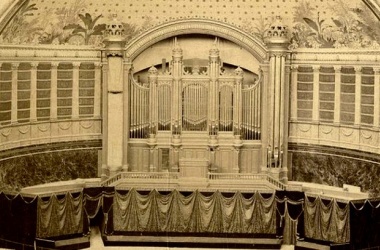
1878: Palais du Trocadéro
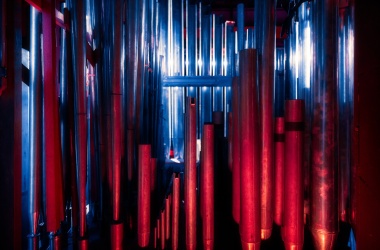
1977: Auditorium de Lyon
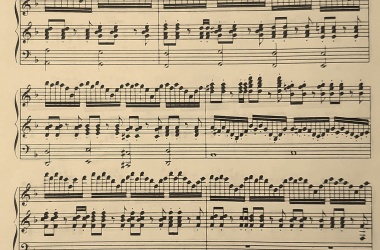
The works premiered on the instrument
